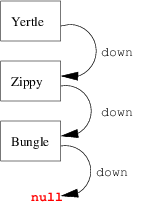|
|
Dr Seuss’ story
Yurtle the
Turtle![]() describes how a turtle called Yurtle sits at the top of a pile
of other turtles. In this example, the pile of turtles is represented
by a linked list of Turtle objects, with the down property
serving to connect one Turtle object to another. If a
Turtle object has a non-null down property, then this
represents a turtle that is sitting below the current one. The last
turtle in the linked list is the turtle that is at the bottom of the
pile, which has a null value for its down property.
describes how a turtle called Yurtle sits at the top of a pile
of other turtles. In this example, the pile of turtles is represented
by a linked list of Turtle objects, with the down property
serving to connect one Turtle object to another. If a
Turtle object has a non-null down property, then this
represents a turtle that is sitting below the current one. The last
turtle in the linked list is the turtle that is at the bottom of the
pile, which has a null value for its down property.
Question 14.1: Study, compile and run the following code:
class Turtle begin private property String name; // Turtle's name private property int age; // Turtle's age in years private property double weight; // Turtle's weight in kg // NOTE: this property allows for linked lists property Turtle down; constructor Turtle(String aName, int anAge, double aWeight) begin name = aName; age = anAge; weight = aWeight; end /** Getter method for name property */ method String getName() begin return name; end /** Useful method for debugging */ public method String toString() begin return name; end end class TurtleTest begin beginMain var Turtle yertle = new Turtle("Yurtle", 103, 20); var Turtle zippy = new Turtle("Zippy", 102, 30); var Turtle bungle = new Turtle("Bungle", 101, 40); // *** see later yertle.down = bungle; bungle.down = zippy; zippy.down = null; // NOTE: not needed as zippy.down is null by default var int totalWeight = 0; for (var Turtle current = yertle; current != null; current=current.down) begin totalWeight += current.getWeight(); end System.out.println("The total weight is " + totalWeight); endMain end
The code in the main function after the *** sets up the following relationships between the three Turtle objects (Bungle, Zippy and Yurtle). The following diagram shows the relationship between the different turtles. When you traverse the list of turtles you must always start at the top turtle (known as the head of the linked list). If you give a different value for the top turtle, your code will think that the given turtle is the one at the top of the pile and you will get the wrong result.

Question 14.2: Move the code for calculating the total weight of the turtles from the main function to a function called function void printTotalWeight(Turtle top) in the Turtle class that prints out the total weight of the turtles. Then call that function from the main function to get the same result as before. Note that that if printTotalWeight was a method then calling that method using null (representing an empty list) like so: null.printTotalWeight() would be an error, whereas Turtle.printTotalWeight(null) wouldn’t be and therefore is better. This is one example of how methods and functions differ.
Question 14.3: Revision question for getters. By copying the pattern established by the getName method, add two getter methods to the Turtle class: getAge which returns the current turtle’s age and getWeight which returns the current turtle’s weight. Then call these methods on the Yurtle object in the main function. Note that the toString method would be more appropriate as it handles nulls better but you known that the yertle reference is not null so you know it is safe to call the getAge and getWeight methods on the yertle reference.
Question 14.4: Write a function Turtle findBottomTurtle(Turtle top) that returns the Turtle object that is at the top of the pile, and returns null if there isn’t one.
Question 14.5: Then call this function from the main function using System.out.println() and the top turtle yertle.
Question 14.6: Write a function Turtle findOldestTurtle(Turtle top) that returns the oldest turtle or null if there isn’t one.
Question 14.7: Then call this function from the main function using System.out.println() and the top turtle yertle.
Question 14.8: Write a function Turtle findHeaviestTurtle(Turtle top) returns the heaviest turtle, or null if there isn’t one.
Question 14.9: Then call this function from the main function using System.out.println() and the top turtle yertle.
Question 14.10: Write a function void sayPile(Turtle top) that prints the names of the turtles in the pile starting from the top turtle and finishing at the bottom turtle. Then call this function from the main function.
Question 14.11: Under what circumstances would it be okay to change the visibility of the down property to private, like the name, age and weight properties?
Question 14.11: Add an extra parameter to the constructor which is a reference the to the turtle below of the current one. Then remove all occurrences of the down property from the main function. The advantage of this is that it enables you to change the visibility of the down property to private.
| Back to J.T.W |
|
This page has the following hit count:
|